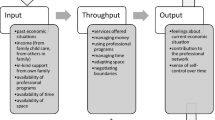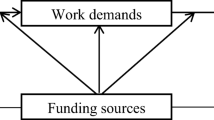Abstract
This study investigates the decision to outsource child care among families involved in family-owned businesses. A management framework is used to examine the impact of inputs to the decision (i.e., goals and resources) and level of management activity (i.e., planning and implementing) in these families as predictors of the choice to outsource child care. The data are a sub-sample of the data from a project entitled, “Family Businesses: Interaction in Work and Family Spheres” (Winter, Fitzgerald, Heck, Haynes, & Danes, 1998) undertaken in 1997. Study findings indicate that household managers who work in the family business are less likely to outsource child care compared to those who work outside the family business. More educated household managers purchased more, and managers in larger families fewer hours of child care. Female household managers purchased significantly fewer hours of child care compared to their male counterparts.
Similar content being viewed by others
References
Avery, R. J., Bryant, W. K., Douthitt, R. A., & McCullough, J. (1996). Lessons from the past. Directions for the future. In R. J. Avery (Ed.), Household time use: Research in the 21st century (pp. 409-418). [Special issue]. Journal of Family and Economic Issues.
Blau, D. M., & Robins, P. K. (1988). Child care costs and family labor supply. Review of Economics and Statistics, 70 374-381.
Brayfield, A. (1995). Juggling jobs and kids: The impact of employment schedules on fathers' caring for children. Journal of Marriage and the Family, 57, 321-330.
Caruso, G. (1992). Patterns of maternal employment and child care for a sample of twoyear-olds. Journal of Family Issues, 13, 297-312.
Connelly, R. M. (1992). Self-employment and providing child care. Demography, 29, 17-29.
Constantine, L. L. (1986). Family paradigms: The practice of theory in family therapy. New York: Guilford.
Cragg, J. G. (1971). Some statistical models for limited dependent variables with application to the demand for durable goods. Econometrica, 39(5), 829-844.
Danes, S. M., Zuiker, V., Kean, R., & Arbuthnot, J. (1999). Predictors of family business tensions and goal achievement. Journal of the Family Firm Institute, 12 241-252.
Dawson, D. A., & Cain, V. S. (October, 1990). Child care arrangements, health of our nation's children, United States, 1988. Advance Data, 187.
Deacon, R. E., & Firebaugh, F. M. (1988). Family resource management principles and application (2nd ed.). Boston: Allyn and Bacon, Inc.
Doherty, W. J., & Colangelo, N. (1984). The family FIRO Model: A modest proposal for organizing family treatment. Journal of Marital and Family Therapy, 10 19-29.
Doherty, W., Colangelo, N., & Hovander, D. (1991). Priority setting in family change and clinical practice: The family FIRO Model. Family Process, 30 227-240.
Folk, K. F., & Beller, A. H. (1993). Part-time work and child care choices for mothers of preschool children. Journal of Marriage and the Family, 55 146-157.
Greene, W. H. (1998). LIMDEP Version 6.0 User's Manual and Reference Guide. Bellport, NY: Econometric Software, Inc.
Greene, W. H. (1998). Econometric analysis (3rd ed.). New Jersey: Prentice Hall.
Hayghe, H. V. (1997). Developments in women's labor force participation. Monthly Labor Review, 120(9), 41-46.
Haynes, D. C. (1997). The determinants of fathers' time spent in regular child care. Family Economics and Resource Management Biennial, 2, 51-58.
Heck, R. K. Z., Winter, M., & Stafford, K. (1992). Managing work and family in homebased employment. Journal of Family and Economic Issues, 13, 187-212.
Hofferth, S. L. (1989). What is the demand for and supply of child care in the United States? Young Children, 44, 28-33.
Hofferth, S. L., & Wissoker, D. A. (1992). Price, quality, and income in child care choice. Journal of Human Resources, 27(1), 70-111.
Hollander, B., & Elman, N. (1988). Family-owned businesses: An emerging field of inquiry. Family Business Review, 1, 145-164.
Horvath, F. W. (1986). Work at home: New findings from the current population survey. Monthly Labor Review, 109(11), 31-35.
Hunts, H., Danes, S., Haynes, D. C., & Heck, R. K. Z. (In press). Home-based employment: Relating gender and household structure to management and child care. In C. Hennon, S. Loker, & R. Walker (Eds.), Gender and home-based employment. West Port, CT: Auburn House.
Joesch, J. M. (1998). Where are the children? Extent and determinants of preschoolers' child care time. Journal of Family and Economic Issues, 19, 75-99.
Kantor, D., & Lehr, W. (1975). Inside the family: Toward a theory of family process. New York: Harper Colophon.
LeClere, M. J. (1994). The decomposition of coefficients in censored regression models: Understanding the effect of independent variables on taxpayer behavior. National Tax Journal, 47, 837-846.
Lehrer, E. (1983). Determinants of child care mode choice: An economic perspective. Social Science Research, 12, 69-80.
Leibowitz, A., Klerman, J. A., & Waite, L. J. (1992). Employment of new mothers and child care choice: Differences by children's age. Journal of Human Resources, 27(1), 112-134.
Leibowitz, A., Waite, L. J., & Witsberger, C. (1988). Child care for preschoolers: Differences by child's age. Demography, 25(2) 205-220.
McDonald, J. F., & Moffitt, R. A. (1980). The uses of Tobit analysis. The Review of Economics and Statistics, 62(2), 318-321.
Michalopoulos, C., Robins P. K., & Garfinkel, I. (1992). A structural model of labor supply and child care demand. Journal of Human Resources, 27, 166-203.
Olson, M. H. (1983). Overview of work-at-home trends in the United States. New York: New York University Press.
Owen, A. J., Rowe, B. R., & Gritzmacher, J. E. (1992). Building family functioning scales into the study of at-home income generation. Journal of Family and Economic Issues, 13 299-313.
Pratt, J. H. (1984). Home teleworking: A study of its pioneers. Technological Forecasting and Social Change, 25, 1-14.
Pratt, J. H. (1993). Myths and realities of working at home: Characteristics of homebased business owners and telecommuters (U.S. Small Business Administration, Office of Advocacy Contract SBA-6647-OA-91). Washington, D.C.: U.S. Government Printing Office.
Presser, H. B. (1988). Shiftwork and child care among young dual-earner American parents. Journal of Marriage and the Family, 50, 133-148.
Ribar, D. C. (1992). Child care and the labor supply of married women: Reduced form evidence. Journal of Human Resources, 27, 134-165.
Robinson, J. (1997). Time for life: The surprising ways Americans use their time. University Park, PA: The Pennsylvania State University Press.
Roncek, D. W. (1992). Learning more from Tobit coefficients: Extending a comparative analysis of political protest. American Sociological Review, 57 503-507.
Smilkstein, G. (1978). Family APGAR: A proposal for family function test and in use by physicians. Journal of Family Practice, 6, 1231-1239.
Smilkstein, G. (1993). Family APGAR analyzed. Family Medicine, 25(5), 293.
Stafford, K., Winter, M., Duncan, K. A., & Genalo, M. A. (1992). Studying at-home income generation. Issues and methods. Journal of Family and Economic Issues, 13 139-158.
Ward, J. L. (1987). Keeping the family business healthy: How to plan for continuing growth, profitability, and family leadership. San Francisco: Jossey-Bass.
Winter, M., Fitzgerald, M. A., Heck, R. K. Z., Haynes, G. W., & Danes, S. W. (1998). Revisiting the study of family businesses: Methodological challenges, dilemmas, and alternative approaches. Family Business Review, 11 239-252.
Winter, M., Puspitawati, H., Heck, R. K. Z., & Stafford, K. (1993). Time-management strategies used by households with home-based work. Journal of Family and Economic Issues, 14 69-92.
Yeager, K. A. (1977, December). Modal choice in the demand for child care by working women (Working Paper No. 105). Princeton, NJ: Princeton University, Industrial Relations Section.
Author information
Authors and Affiliations
Rights and permissions
About this article
Cite this article
Avery, R.J., Haynes, D.C. & Haynes, G.W. Managing Work and Family: The Decision to Outsource Child Care in Families Engaged in Family-Owned Businesses. Journal of Family and Economic Issues 21, 227–258 (2000). https://doi.org/10.1023/A:1009433317645
Issue Date:
DOI: https://doi.org/10.1023/A:1009433317645




